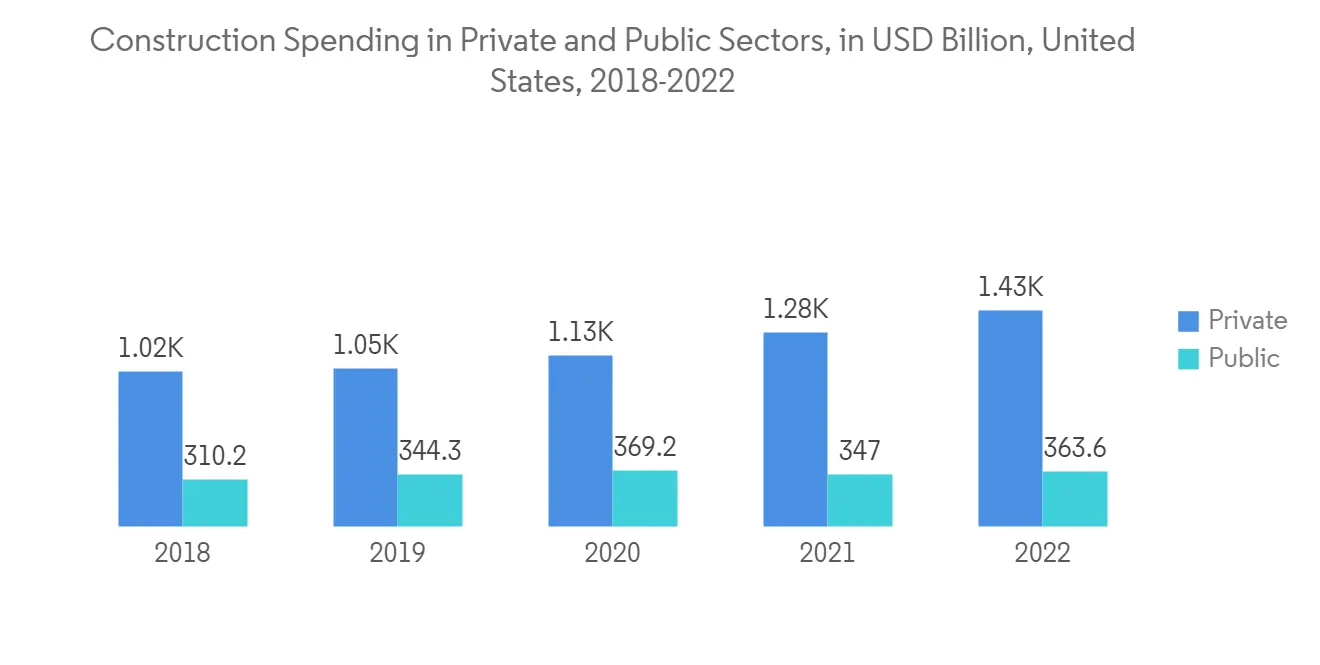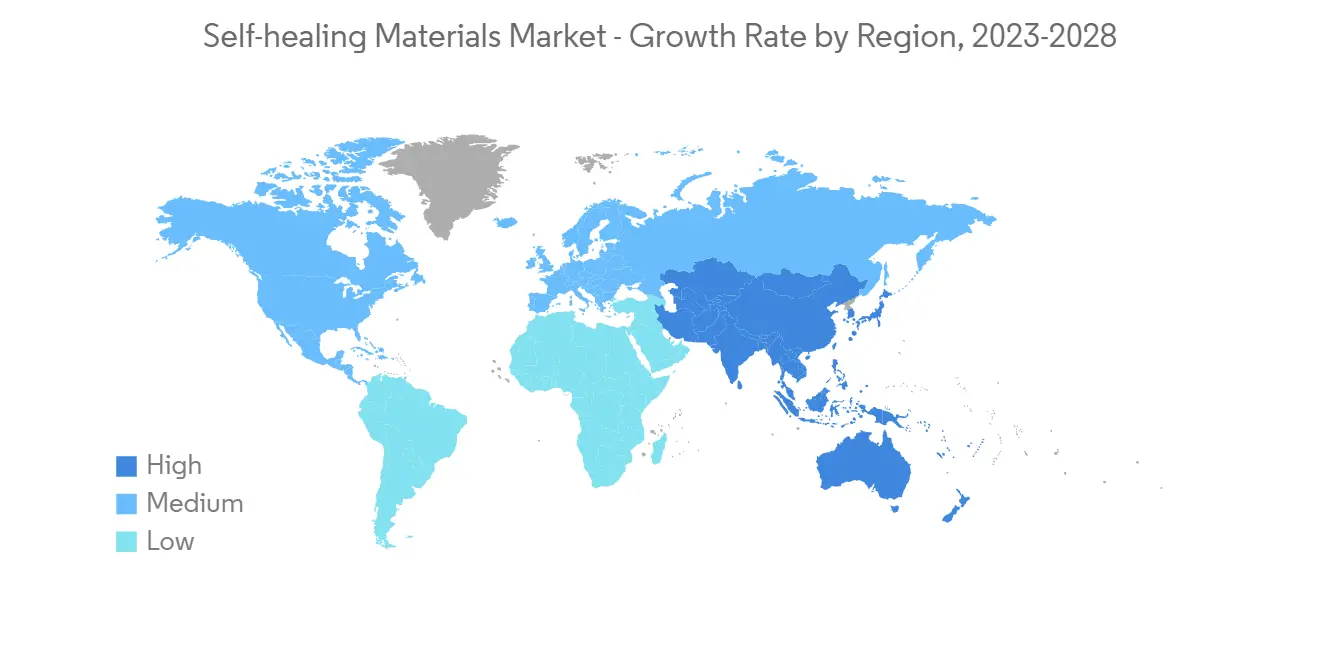 |
市場調查報告書
商品編碼
1273456
自修復材料市場 - COVID-19 的增長、趨勢、影響和預測 (2023-2028)Self-healing Materials Market - Growth, Trends, and Forecasts (2023 - 2028) |
||||||
※ 本網頁內容可能與最新版本有所差異。詳細情況請與我們聯繫。
在預測期內,自愈材料市場的複合年增長率預計將超過 20%。
COVID-19 極大地影響了物流和製造業,阻礙了市場增長。 然而,該行業開始復蘇,此後汽車、建築和航空航天行業的穩步擴張一直在推動市場。
主要亮點
- 新興國家/地區建築業的發展是推動市場發展的主要因素之一。 此外,在醫療保健行業仿生學中越來越多地使用自修復材料也可能推動市場。
- 但是,與傳統材料相比,自修復材料的高成本阻礙了所研究市場的增長。
- 在汽車和電子行業,由於意識的增強,自愈材料的採用正在增加,這看起來是一個很好的市場機會。
- 預計亞太地區在預測期內的增長率最高。
自修復材料的市場趨勢
建築業主導市場
- 自修復材料在建築行業中發揮著重要作用。 這些材料具有快速修復裂縫的潛力,因為自我修復過程可以實現快速修復。 它用於混凝土中以加強和延長建築物和橋樑等結構的壽命。
- 全球建築業的不斷發展預計會增加對自修復材料的需求。
- 美國人口普查局公佈的數據顯示,2023 年 1 月經季節性調整後的私人住宅年化率為 133.9 萬套,比 12 月修正後的 133.7 萬套高出 0.1 個百分點。
- 此外,根據美國人口普查局的統計報告,2023 年 1 月私人擁有的房屋竣工數量經季節調整後的年率為 140.6 萬套,比 12 月修正後的數字 139.2 萬套增長 1.0%。比 2022 年 1 月的 1,247,000 套增長 12.8%。
- 除了開發新房外,美國還在房屋裝修方面投入巨資。 隨著該國不斷增長的移民人口,對康復的需求也在增加。 人們越來越意識到可持續性和高效建設的重要性也推動了修復趨勢。
- 德國還批准在 2022 年 10 月建造 25,399 個住宅單元。 根據聯邦統計局 (Destatis) 的數據,這反映出自 2021 年 10 月以來建築許可數量下降了 14.2%。 此外,在 2022 年 1 月至 2022 年 10 月期間頒發了 297,453 個住宅建築許可證。
- 世界各地的所有這些建築活動都在增加行業對自修復材料的需求,並推動市場向前發展。

亞太地區增長率最高
- 近年來,亞太地區對自愈材料的需求顯著增加,尤其是在中國和印度。 由於自修復材料的壽命、耐用性、安全性、效率和性能的提高,預計亞太地區自修復材料的消費量將快速增長。
- 中國的建築業發展迅速。 根據中國國家統計局的數據,2022 年第四季度中國的建築產值約為 2760 億元人民幣(400 億美元),比上一季度增長 50%。
- 在接下來的七年裡,印度預計將投資約 1.3 萬億美元用於住房建設,並建造 6000 萬套新房。 印度也將超越其到 2025 年成為世界第三大建築市場的目標。 對於建築業,政府已在 2022-23 年聯邦預算中向道路、運輸和公路部撥款 60,000 印度盧比(77.2 億美元)。
- 根據日本國土交通省的數據,2022 年建築業的總投資預計將同比增長 0.6%,達到約 66.99 萬億日元(5081.6 億美元)。
- 此外,日本電子信息技術產業協會 (JEITA) 估計,截至 2022 年 11 月,日本電子行業的總產值約為 10.1 萬億日元(845 億美元),約為之前的 100.7%年。 此外,截至 11 月,日本電子設備的出口額與去年同期相比增長了近 15%。
- 因此,建築活動的增加、汽車行業的崛起以及電子行業的蓬勃發展正在促進自修復材料和其他應用的增長,預計這些應用將在預測期內提振市場。

自愈材料行業概況
自愈材料市場由於頂級公司佔據了大量市場份額而適度整合。 市場上的主要參與者包括(排名不分先後)Autonomic Materials, Inc.、The Goodyear Tire and Rubber Company、NEI Corporation.、BASF SE 和 Bayer AG。
其他福利:
- Excel 格式的市場預測 (ME) 表
- 3 個月的分析師支持
內容
第一章介紹
- 調查先決條件
- 本次調查的範圍
第二章研究方法論
第 3 章執行摘要
第四章市場動態
- 主持人
- 建築業發展進展
- 擴大自修復材料在仿生學中的應用
- 其他司機
- 約束因素
- 自愈材料成本高
- 其他抑製劑
- 工業價值鏈分析
- 波特的五力分析
- 供應商的議價能力
- 消費者的議價能力
- 新進入者的威脅
- 替代品的威脅
- 競爭程度
第 5 章市場細分
- 類型
- 聚合物
- 複合
- 陶瓷
- 混凝土
- 其他類型
- 最終用戶行業
- 醫療保健
- 汽車
- 電氣/電子
- 建築學
- 航空航天
- 其他最終用戶行業
- 地區
- 亞太地區
- 中國
- 印度
- 日本
- 韓國
- 東盟國家
- 其他亞太地區
- 北美
- 美國
- 加拿大
- 墨西哥
- 歐洲
- 德國
- 英國
- 意大利
- 法國
- 其他歐洲
- 南美洲
- 巴西
- 阿根廷
- 其他南美洲
- 中東和非洲
- 沙特阿拉伯
- 南非
- 其他中東和非洲地區
- 亞太地區
第六章競爭格局
- 併購、合資、合作、合同等。
- 市場份額 (%)/排名分析
- 主要公司採用的策略
- 公司簡介
- Acciona, S.A.
- Apple Inc.
- Autonomic Materials, Inc.
- BASF SE
- Bayer AG
- Covestro AG
- Evonik Industries AG
- MacDermid Autotype Ltd.
- Michelin North America Inc.
- NEI Corporation
- The Goodyear Tire and Rubber Company
第七章市場機會與未來趨勢
- 在汽車和電子行業中擴大採用自修復材料
The self-healing materials market is expected to register with a CAGR greater than 20% during the forecast period.
COVID-19 had a significant impact on the logistics and manufacturing industries, thus hampering the market growth. However, the industry started to recover, and from that onwards, the market is driven by steady expansion in the automotive, construction, and aerospace industries.
Key Highlights
- The increased development in the construction industry in emerging countries is one of the primary factors driving the market. The growing use of self-healing materials in biomimetics for the healthcare industry is also likely to propel the market.
- However, the high cost of self-healing materials as compared to conventional materials is hindering the growth of the market studied.
- The increasing adoption of self-healing materials in the automobile and electronics industry on the back of rising awareness is likely to act as an opportunity for the market studied.
- Asia-Pacific is expected to witness the highest growth rate during the forecast period.
Self-healing Materials Market Trends
Construction Inudstry to Dominate the Market
- Self-healing materials play an essential role in the construction industry. These materials include the potential to rapidly fix the cracks as the self-healing process allows speedy treatment. It is used in concrete to strengthen and extend the life of buildings, bridges, and other structures.
- The ever-increasing global construction industry will likely increase the demand for self-healing materials.
- According to the US Census Bureau, the seasonally adjusted annual rate of privately owned housing units approved by building permits in January 2023 was 1,339,000, 0.1 percentage point higher than the revised December estimate of 1,337,000.
- The same statistical report by US Census Bureau also stated that privately owned housing completions were at a seasonally adjusted annual rate of 1,406,000 in January 2023, up 1.0% from the revised December estimate of 1,392,000 and 12.8% from the January 2022 pace of 1,247,000.
- Aside from new home development, the United States is investing heavily in home improvements. The necessity for rehabilitation became increasingly critical as the country's migrant population grew. In addition, the increased awareness of the importance of sustainability and high-efficiency constructions also fueled the restoration trend.
- Germany also approved the construction of 25,399 dwellings for October 2022. According to the Federal Statistics Office (Destatis), this reflects a 14.2% decrease in building permits from October 2021. Also, 297,453 residential building licenses were issued between January and October 2022.
- All these construction activities in various locations worldwide increase the demand for self-healing materials in the industry, propelling the market ahead.

Asia-Pacific to Witness the Highest Growth Rate
- In recent years, Asia-Pacific saw a considerable increase in demand for self-healing materials, particularly from China and India. The Asia-Pacific region's consumption of self-healing materials is predicted to skyrocket due to the materials' increasing lifespan, durability, safety, efficiency, and performance.
- China's building industry is expanding at a rapid pace. According to the National Bureau of Statistics of China, construction output in China was valued at around CNY 276 billion (USD 40 billion) in the fourth quarter of 2022, representing a 50% increase over the previous quarter.
- Over the next seven years, India is anticipated to see an investment of roughly USD 1.3 trillion in housing, with 60 million new dwellings being constructed. India also plans to surpass its goal of becoming the world's third-largest building market by 2025. Regarding the construction industry, the government allocated INR 60,000 crores (USD 7.72 billion) for the Ministry of Road Transport and Highways in the Union Budget 2022-23.
- According to Japan's Ministry of Land, Infrastructure, Transport, and Tourism (MLIT), overall investment in the construction sector in 2022 is expected to be around JPY 66,990 billion (USD 508.16 billion), a 0.6% increase over the previous year.
- Moreover, the Japan Electronics and Information Technology Industries Association (JEITA) estimated the overall production value of the electronics sector in Japan to be around JPY 10.1 trillion (84.5 USD billion) as of November 2022, roughly 100.7% of the value from the previous year. When compared to the prior year, the exports of electronics from Japan also increased by almost 15% up until November as compared to the previous year.
- Thus, the growing construction activities, the increasing automobile industry, and the rising electronics sector are instrumental in the growth of self-healing materials and other applications, which would boost the market during the forecast period.

Self-healing Materials Industry Overview
The self-healing materials market is moderately consolidated as the top players account for a significant market share. Some of the key players in the market include (not in any particular order) Autonomic Materials, Inc., The Goodyear Tire and Rubber Company, NEI Corporation., BASF SE, and Bayer AG, among others.
Additional Benefits:
- The market estimate (ME) sheet in Excel format
- 3 months of analyst support
TABLE OF CONTENTS
1 INTRODUCTION
- 1.1 Study Assumptions
- 1.2 Scope of the Study
2 RESEARCH METHODOLOGY
3 EXECUTIVE SUMMARY
4 MARKET DYNAMICS
- 4.1 Drivers
- 4.1.1 Increased Development in the Construction Industry
- 4.1.2 Growing Use of Self-healing Materials in Biomimetics
- 4.1.3 Other Drivers
- 4.2 Restraints
- 4.2.1 High Cost of Self-healing Materials
- 4.2.2 Other Restraints
- 4.3 Industry Value-chain Analysis
- 4.4 Porter's Five Forces Analysis
- 4.4.1 Bargaining Power of Suppliers
- 4.4.2 Bargaining Power of Consumers
- 4.4.3 Threat of New Entrants
- 4.4.4 Threat of Substitute Products and Services
- 4.4.5 Degree of Competition
5 MARKET SEGMENTATION (Market Size in Value)
- 5.1 Type
- 5.1.1 Polymers
- 5.1.2 Composites
- 5.1.3 Ceramics
- 5.1.4 Concrete
- 5.1.5 Other Types
- 5.2 End-user Industry
- 5.2.1 Healthcare
- 5.2.2 Automotive
- 5.2.3 Electrical and Electronics
- 5.2.4 Construction
- 5.2.5 Aerospace
- 5.2.6 Other End-user Industries
- 5.3 Geography
- 5.3.1 Asia-Pacific
- 5.3.1.1 China
- 5.3.1.2 India
- 5.3.1.3 Japan
- 5.3.1.4 South Korea
- 5.3.1.5 ASEAN Countries
- 5.3.1.6 Rest of Asia-Pacific
- 5.3.2 North America
- 5.3.2.1 United States
- 5.3.2.2 Canada
- 5.3.2.3 Mexico
- 5.3.3 Europe
- 5.3.3.1 Germany
- 5.3.3.2 United Kingdom
- 5.3.3.3 Italy
- 5.3.3.4 France
- 5.3.3.5 Rest of Europe
- 5.3.4 South America
- 5.3.4.1 Brazil
- 5.3.4.2 Argentina
- 5.3.4.3 Rest of South America
- 5.3.5 Middle-East and Africa
- 5.3.5.1 Saudi Arabia
- 5.3.5.2 South Africa
- 5.3.5.3 Rest of Middle-East and Africa
- 5.3.1 Asia-Pacific
6 COMPETITIVE LANDSCAPE
- 6.1 Mergers and Acquisitions, Joint Ventures, Collaborations, and Agreements
- 6.2 Market Share(%) **/Ranking Analysis
- 6.3 Strategies Adopted by Leading Players
- 6.4 Company Profiles
- 6.4.1 Acciona, S.A.
- 6.4.2 Apple Inc.
- 6.4.3 Autonomic Materials, Inc.
- 6.4.4 BASF SE
- 6.4.5 Bayer AG
- 6.4.6 Covestro AG
- 6.4.7 Evonik Industries AG
- 6.4.8 MacDermid Autotype Ltd.
- 6.4.9 Michelin North America Inc.
- 6.4.10 NEI Corporation
- 6.4.11 The Goodyear Tire and Rubber Company
7 MARKET OPPORTUNITIES AND FUTURE TRENDS
- 7.1 Increasing Adoption of Self-healing Materials in the Automobile and Electronics Industry













